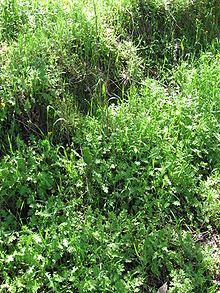| Carduus pycnocephalus | |
|---|---|

| |
| Carduus pycnocephalus flowers (Italy). | |
| Scientific classification | |
| Kingdom: | Plantae |
| Clade: | Tracheophytes |
| Clade: | Angiosperms |
| Clade: | Eudicots |
| Clade: | Asterids |
| Order: | Asterales |
| Family: | Asteraceae |
| Genus: | Carduus |
| Species: | C. pycnocephalus |
| Binomial name | |
| Carduus pycnocephalus L. | |
Carduus pycnocephalus, with common names including Italian thistle, Italian plumeless thistle, and Plymouth thistle, is a species of thistle. It is native to the Mediterranean region in southern Europe, North Africa, and Western Asia; Eastern Europe and the Caucasus; and the Indian Subcontinent.
The plant has become an introduced species in other regions, and on other continents, often becoming a noxious weed or invasive species.
Description

A winter annual, Carduus pycnocephalus has stems ranging from 8 inches (20 cm) to 6.6 feet (2.0 m), glabrous to slightly wooly. The multiple stems are winged with spines.
The plant grows in a rosettes of 10–14 inches (25–36 cm) in diameter, with four to ten lobed basal leaves that are 4–6 inches (10–15 cm) long. Cauline leaves are tomentose on the underside and contain spines on the lobe tips.
Flower heads are 2–5 per cluster, densely matted with cobwebby hairs at the base of the phyllaries and spiny towards the tips. Corollas are pink to purple, approx. 1.0–1.4 cm (0.4–0.6 in) long, and the fruits are brown to gold, with a bristly, minutely barbed pappus.
Noxious weed

Carduus pycnocephalus has become a noxious weed in Australia, New Zealand, Macaronesia, South Africa, the Arabian Peninsula, South America, Hawaii, and North America, especially in much of California. It is a C-listed weed by the California Department of Agriculture and a Moderate Invasive Plant rating by the California Invasive Plant Council. It favors grasslands, woodlands, and chaparral vegetation types, but is especially prevalent in oak woodlands in and around the Central Valley. It is found in disturbed areas, often with basaltic soils, fertile soils, or soils with a relatively high pH (> 6.5).
Impacts
Italian thistle can grow densely, crowding out other vegetation with dense rosette 'colonies' in the winter, thereby preventing establishment of native plants. Its spiny leaves, stems, and phyllaries prevent animals from grazing on it and nearby forage. Its tendency to grow under the canopy of oaks increases the risk of wildfire damage to the trees, as fire can more easily spread to the canopy.
Control
- Mechanical
Mechanical methods can be effective but must be done before the plant sets seed. Additionally, the root must be severed at least 4 inches (10 cm) below the ground to prevent the plant from regenerating. Mowing and slashing are not reliable as the plant is able to regrow and produce seed even at a height of 3 inches (7.6 cm).
- Biological
Biological control agents have limited success with Carduus pycnocephalus. Insects that tested host-specific by the California Department of Agriculture and caused significant damage to the reproductive structures of the Italian thistle have not been utilized, due to concerns about possible predation of California's native thistle species. Puccinia cardui-pycnocephali is a species of rust (fungus) apparently exclusive to Carduus pycnocephalus. Other rust species have been found on Italian thistle as well.
Grazing by sheep or goats (not cattle) in Australia has showed promise as well.
- Chemical
Chemical control can be achieved with a variety of products, including clopyralid, glyphosate, Diquat, Picloram, and 2, 4-D ester. However, caution must be exercised when using these products, and their use is not always appropriate, especially near water surfaces and other sensitive natural habitats.
References
- BSBI List 2007 (xls). Botanical Society of Britain and Ireland. Archived from the original (xls) on 2015-06-26. Retrieved 2014-10-17.
- ^ "Carduus pycnocephalus". Germplasm Resources Information Network. Agricultural Research Service, United States Department of Agriculture. Retrieved 2013-04-08.
- ^ U.S. National Park Service: Invasive Non-Native Plants in Sequoia and Kings Canyon National Parks — Italian Thistle
- Jepson; Hickman 1993
- ^ Bossard, CC., J.M. Randall, and M. Hoshovsky. (eds.); Invasive Plants of California’s Wildlands; University of California Press, Berkeley, CA; 2000.
- USDA
- ^ Cal-IPC—California Invasive Plant Council species treatment: Carduus pycnocephalus . accessed 4.8.2013
- ^ Mattole Restoration Council: Italian Thistle (Carduus pycnocephalus) . accessed 4.8.2013
- Parsons 1973
- Tasmania Dept. of Agriculture 1977
- Sheppard et al. 1991
- Olivieri 1984
- Bruckart 1991
- Bendall 1973
External links
- USDA Plants Profile: Carduus pycnocephalus (Italian plumeless thistle)
- Jepson Manual Treatment — Carduus pycnocephalus
- Carduus pycnocephalus — CalPhoto gallery
| Taxon identifiers | |
|---|---|
| Carduus pycnocephalus |
|
- Carduus
- Flora of North Africa
- Flora of Western Asia
- Flora of Europe
- Flora of Afghanistan
- Flora of Egypt
- Flora of Greece
- Flora of the Indian subcontinent
- Flora of Iran
- Flora of Iraq
- Flora of Israel
- Flora of Italy
- Flora of Jordan
- Flora of Libya
- Flora of Morocco
- Flora of Palestine (region)
- Flora of Spain
- Flora of Switzerland
- Flora of Ukraine